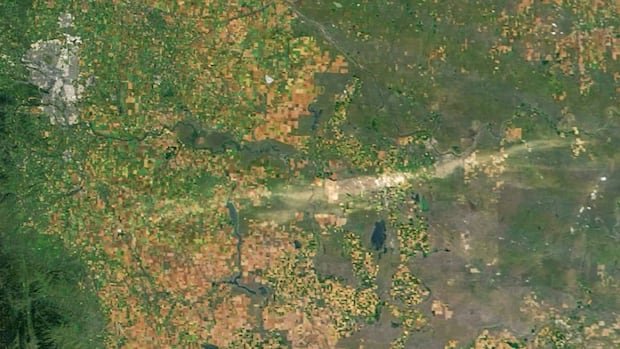Strong winds and hail that swept through southern Alberta in the past month have left a significant mark visible even from outer space. On August 20, 2025, gusts reaching speeds of 150 kilometers per hour ravaged crops and stripped grass and ground cover across a vast area extending from south of Calgary to Saskatchewan, impacting around 425,000 acres of insurable crops, pastures, and native grasslands.
The most severe section of the storm, which spanned hundreds of kilometers, created a distinct “hail scar” that is discernible in satellite images released by NASA. This scar, approximately 15 kilometers wide and 200 kilometers long, replaced a patchwork of green shades with a visible smear. The area worst hit was centered north of Brooks, where agricultural properties suffered extensive damage, including demolished home siding, shredded corn stalks, overturned irrigation pivots, and stripped asphalt shingles.
According to findings from researchers at Western University’s Northern Hail Project, the storm caused some of the most severe damage documented by the project, especially in an area located 22 kilometers north of Brooks. The assessment reported total crop destruction with grain crops flattened, corn stalks left bare, grasslands pulverized, and native shrubs stripped on their western sides.
Cleanup efforts are currently underway, with residents and workers in the hardest-hit regions, like Millicent and Brooks, actively engaged in clearing debris and repairing damage. Farmers are facing the task of salvaging any remaining crops, with severely damaged fields being repurposed for livestock feed or plowed under.
The storm’s impact on ranchers is also significant, as the wind flattened grass and exposed root systems in grazing areas, potentially leading to reduced grazing capacity for several years until the pasture regenerates. The financial implications are substantial, with crop insurance providers estimating millions of dollars in damages, particularly as the losses occurred at a mature stage of the crops, leaving little room for recovery.
Looking ahead, experts highlight the importance of managing the recovery process carefully, emphasizing the need to monitor pasture conditions, encourage regrowth, and adjust grazing practices to support land rehabilitation. The healing process for the affected areas is expected to take time, with some regions requiring special management to facilitate recovery and re-establish vegetation cover.
The aftermath of the storm serves as a stark reminder of the unpredictable and devastating nature of severe weather events in the region, underscoring the resilience and adaptability required by farmers and ranchers to navigate such challenges successfully.


